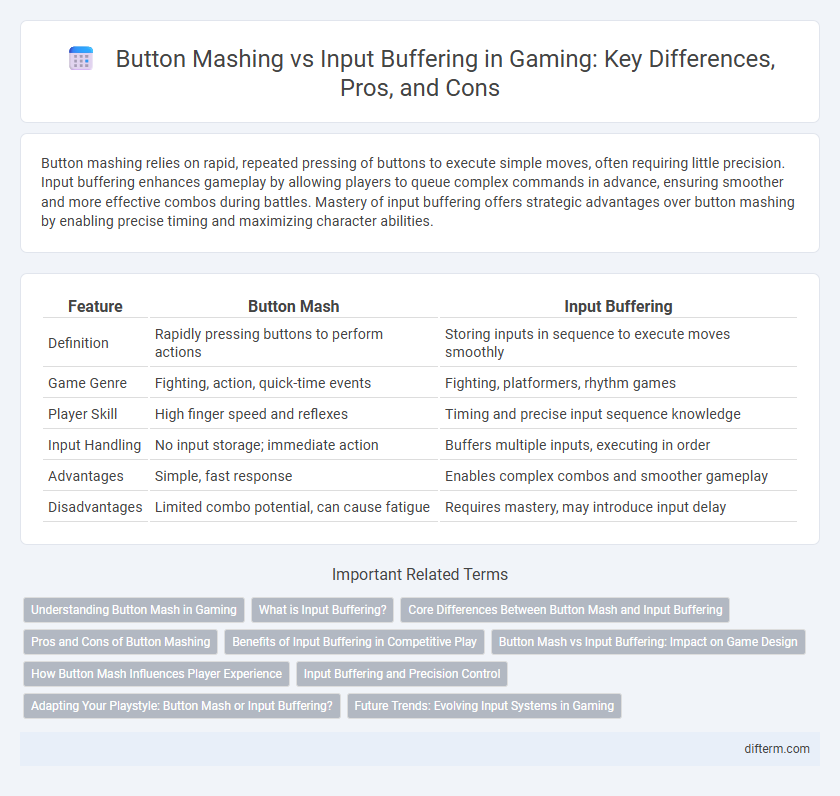Button mashing relies on rapid, repeated pressing of buttons to execute simple moves, often requiring little precision. Input buffering enhances gameplay by allowing players to queue complex commands in advance, ensuring smoother and more effective combos during battles. Mastery of input buffering offers strategic advantages over button mashing by enabling precise timing and maximizing character abilities.
Table of Comparison
| Feature | Button Mash | Input Buffering |
|---|---|---|
| Definition | Rapidly pressing buttons to perform actions | Storing inputs in sequence to execute moves smoothly |
| Game Genre | Fighting, action, quick-time events | Fighting, platformers, rhythm games |
| Player Skill | High finger speed and reflexes | Timing and precise input sequence knowledge |
| Input Handling | No input storage; immediate action | Buffers multiple inputs, executing in order |
| Advantages | Simple, fast response | Enables complex combos and smoother gameplay |
| Disadvantages | Limited combo potential, can cause fatigue | Requires mastery, may introduce input delay |
Understanding Button Mash in Gaming
Button mash in gaming refers to rapidly and repeatedly pressing a single button or a combination of buttons to execute basic or powerful moves quickly. This technique often relies on speed rather than precision, enabling players to overwhelm opponents in action-packed scenarios. Understanding button mash helps players recognize its limitations and when to transition to more skillful strategies like input buffering for executing complex combos.
What is Input Buffering?
Input buffering is a technique in gaming that records player inputs ahead of time and processes them at the exact frame when the game character can perform the action. This method reduces the frustration of missed commands by allowing precise execution of moves even during high-paced gameplay. By queuing actions, input buffering ensures smoother and more responsive control compared to button mashing, enhancing player performance in fighting and action games.
Core Differences Between Button Mash and Input Buffering
Button mash involves rapidly pressing buttons with minimal timing, relying on speed and randomness, while input buffering stores player inputs in a queue that the game executes sequentially, ensuring precise move timing. Button mashing emphasizes raw button presses and reaction speed, whereas input buffering allows players to perform complex combos by preloading commands even during animations or delays. Core differences lie in execution precision, with button mashing being spontaneous and input buffering enabling strategic, timed inputs for optimized gameplay performance.
Pros and Cons of Button Mashing
Button mashing offers an immediate and intuitive way to input commands, making it accessible for beginners and enhancing fast-paced gameplay. However, it often sacrifices precision and strategic depth, leading to inconsistent results and increased physical fatigue during extended sessions. While effective for casual play, it may hinder skill development in competitive gaming where input buffering allows for optimized and timed moves.
Benefits of Input Buffering in Competitive Play
Input buffering enhances competitive gaming precision by allowing players to queue multiple commands, reducing input lag and improving reaction timing during high-pressure matches. This technique ensures smoother combos and action sequences, giving players a strategic advantage over button mashing, which often leads to inconsistent moves and wasted inputs. By leveraging input buffering, gamers achieve greater control and efficiency, crucial for mastering complex fighting games and fast-paced esports titles.
Button Mash vs Input Buffering: Impact on Game Design
Button Mash emphasizes rapid, repetitive input, creating intense, skill-based interactions that challenge player reflexes and stamina, whereas Input Buffering allows players to queue commands, enhancing responsiveness and precision in gameplay. The impact on game design manifests in pacing and difficulty balance; Button Mash can generate chaotic, moment-to-moment tension, while Input Buffering supports complex combos and smoother control schemes. Designers must choose between promoting physical dexterity or strategic command timing to shape player experience and game flow effectively.
How Button Mash Influences Player Experience
Button mash gameplay creates a high-energy experience by encouraging rapid, repetitive button presses, which can lead to increased excitement but also player fatigue. This frantic input style often reduces strategic depth, making matches feel more chaotic and less skill-based compared to games utilizing input buffering. As a result, button mashing influences player engagement by emphasizing reflexive action over precision and timing, impacting both accessibility and competitive balance.
Input Buffering and Precision Control
Input buffering significantly enhances gameplay responsiveness by allowing players to queue commands during animations, ensuring precise control over character actions in fast-paced fighting games. This mechanic minimizes input lag and prevents missed moves, emphasizing accuracy and timing rather than rapid, random button mashing. Mastering input buffering empowers gamers to execute complex combos and strategic maneuvers with consistent precision, elevating overall performance.
Adapting Your Playstyle: Button Mash or Input Buffering?
Adapting your playstyle in gaming involves understanding when to rely on button mashing or input buffering to maximize performance. Button mashing offers rapid, instinctive attacks ideal for chaotic, fast-paced scenarios, while input buffering enables precise execution of complex combos by queuing commands ahead of time. Mastery of both techniques allows players to seamlessly switch between aggressive pressure and strategic control, enhancing overall gameplay efficiency.
Future Trends: Evolving Input Systems in Gaming
Button mash and input buffering represent two distinct input systems shaping gaming experiences, with future trends leaning towards hybrid models that combine rapid player reactions and precise timing recognition. Emerging technologies such as AI-driven adaptive input recognition and haptic feedback aim to enhance responsiveness and immersion, creating more dynamic and accessible gameplay. Innovations in cloud gaming and latency reduction also support sophisticated input buffering techniques, allowing for seamless player interactions across diverse devices and network conditions.
Button Mash vs Input Buffering Infographic

 difterm.com
difterm.com